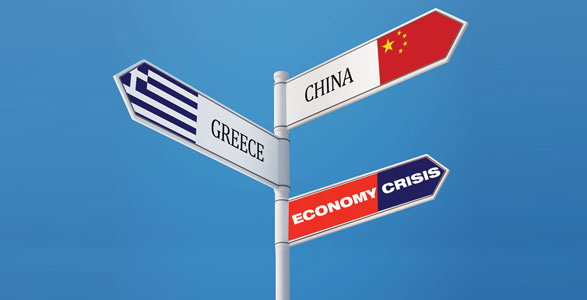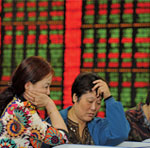
The Indian markets have been resilient in the face of global instability. But dithering on reforms could suck us in too By Kiran Nanda
Global financial volatility and uncertainty have become the ‘Writing on the Wall’ for emerging markets including India. However, India’s large foreign exchange reserves cushion has made the rupee more resilient to global shocks.
Apart from developments like the Greek debt issue and Chinese meltdown, the divergent central bank policies and commodity markets losing their way in the changed environment pose risks of a new crisis. For India, with its appetite for foreign capital amid a number of pressures like the weak domestic activity, poor public finances, indifferent export performance, massive need for international investment in infrastructure and banks and an inflated asset market, the threat of instability in international money markets is real.
Emerging markets have been beneficiaries of strong capital inflows due to low rates prevailing in developed countries coupled with abundant liquidity. The amount of money pumped into global markets has been as much as $10-12 trillion. Today, $200-250 billion in fresh liquidity each quarter may be required globally to simply maintain asset prices. The world is entering a period of asynchronous monetary policy, with divergences among individual central banks. Such a scenario carries the potential to destabilise asset markets.
A ‘Band-Aid’ approach as a solution by Greece and China is working against the ethos of market based solutions. This can cause currency upheavals to recur. The commodity markets are not as volatile as the stock and currency markets. The currency and equity markets are closely connected because of the hot money movement.
The Greek debt and Chinese equity meltdown issues have merely been postponed. In case of Greek crisis only a political bridge amongst creditors --European Countries, European Central Bank (ECB) and International Monetary Fund (IMF)-- has been successfully created. This will have to be quickly followed by economic and social measures to enable realization of the objectives of the European Union. This appears to be a tall order. According to the IMF, the Greek deal is not viable. Two earlier bailouts could not become successful. How can the third bailout which is far stricter than the previous two work? Greece has reluctantly agreed to wide-ranging reforms in order to secure a third bailout from the Euro group. It faces a strict timetable to approve and implement those changes. The conditions agreed will require not only a restructuring of its economy but even its society. Greece, in a way, has now become a financial colony of its creditors. The situation is akin to being in an intensive care unit of fiscal austerity and structural reforms for five years now.
The problems Greece is facing, or the course it is being forced to adopt aren’t altogether novel. Countries in Latin America and Africa been in this territory before. Even the more industrialized and prosperous southern European nations, Spain, Portugal and Italy stared at a similar crisis not too long ago. Only in Greece’s case, the problems are of a much bigger magnitude.
Greece’s debts amounted to €330 billion in 2010, when it first emerged that there could be a he crisis. At that time, its GDP was a mere €226 billion. After five years of EU-ECB-IMF trio’s prescriptions, Greece’s debt stands at €320 billion while its GDP has shrunk further to €178 billion. A consortium of creditors have lent Greece money in this time to repay its old debts, but with a fast contracting economy and no room for public expenditure, the Greek citizens have had to endure high levels of unemployment.
Coming to Chinese meltdown, some damage to its reputation has happened as its actions to stem the meltdown went against the spirit of market principles. Chinese actions can even affect its new increasing role being visualized as a reserve currency in the global economy. China will have to quickly undo the damage. As the process of the data dissemination from China is not sufficiently transparent, it is difficult to surmise and predict exactly what is going to happen next in China.
 It is felt that such upheavals would not impact the Indian equity market to a major extent. The Chinese meltdown has not led to a devastating blow to the Indian equity market. Reasons being (1) Chinese markets, despite falling by 30% in a matter of less than a month, wiping out some $3.5 trillion in wealth, more than the total value of India’s stock market, are still up by 80% over the last one year. Even with this steep fall, the Chinese market continues to be one of the best performing market. (2) The stock market wealth effect in China is much smaller than that of the US. Stocks represent less than 15% of household financial assets in China. Consumption growth in China is largely driven by rise in income rather than change in wealth. (3) Largely Chinese banking sector is not so closely linked to the stock market.
It is felt that such upheavals would not impact the Indian equity market to a major extent. The Chinese meltdown has not led to a devastating blow to the Indian equity market. Reasons being (1) Chinese markets, despite falling by 30% in a matter of less than a month, wiping out some $3.5 trillion in wealth, more than the total value of India’s stock market, are still up by 80% over the last one year. Even with this steep fall, the Chinese market continues to be one of the best performing market. (2) The stock market wealth effect in China is much smaller than that of the US. Stocks represent less than 15% of household financial assets in China. Consumption growth in China is largely driven by rise in income rather than change in wealth. (3) Largely Chinese banking sector is not so closely linked to the stock market.
Chinese slowdown may help some of the fast moving money shift to India and in the process providing stability to the Indian market
India has become much insulated from the two crisis due to its improving economic fundamentals (downward trend of interest rates, declining inflation and long awaited shift of household savings from physical to financial assets finally happening) coupled with prospects of a good monsoon. India has today emerged far stronger and resilient economy than at the time of earlier global financial meltdown. The Chinese slowdown impacting the Indian economy favourably in the long term will mainly depend on Indian authorities’ policy response and agility in executing the decisions taken to counter destabilizing forces and the corporates adopting a pro-active approach of taking advantage of new opportunities.
According to some, the Chinese market crash indicates deeper crisis in China. According to the Economist magazine, “China embraces the markets…A panicked response to tumbling stocks casts doubt on the pace of reform”. The danger now is that China has become more vulnerable to instability.
The stability of the rupee during the China sell-off might have lessons for the future, particularly about the impact of other global ‘shocks’ that might follow. It was as if the market had chosen to ignore the short-term panic and focused on the medium-term benefits such as falling commodity prices and fund flows from China to India. Clearly, a shrinking current account deficit and a large pile of reserves have acted as positives. The Indian rupee may no longer be vulnerable to global events as the country’s foreign exchange reserves are now adequate to fund imports for nearly 11 months. But issues like a growing pile of unhedged foreign currency debt and foreign ownership of local debt are risks that cannot be ignored.
In sum, lesson from recent crisis is that India should concentrate on making its economy strong and growing, avoiding policy flip-flops; it should not be spending beyond its means. The recent Chinese wiping away over 50% of China’s stock market flows illustrates the delicate situation in which one has to contend with the not-so-free market of irrational expectations. SEBI and investment banks have to ensure that the imminent IPO boom does not degenerate into doom as in China. Any sign of irrational exuberance has to be nipped in the bud.
Written By: Kiran Nanda